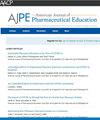通过创新模拟中的实时反馈提高药学学生的电话沟通技巧。
IF 3.5
4区 教育学
Q1 EDUCATION, SCIENTIFIC DISCIPLINES
引用次数: 0
摘要
背景:有效的沟通技巧对药学专业学生至关重要,特别是在远程医疗环境中,清晰和专业的互动至关重要。本研究比较了三种基于模拟的教学方法对药学学生电话沟通能力的提高,重点研究了实时反馈与模拟后反思的影响。方法:以114名台湾五所大学药学专业学生为研究对象,分为三组:(1)标准模拟教学法(STM, n=58)、(2)改良模拟教学法(MSTM, n=21)、(3)改良实时反馈模拟教学法(MSTM+RTF, n=35)。所有学生都参与了标准化的临床场景,旨在模拟常见的与药学相关的询问。在5分李克特量表上使用一份经过验证的15项问卷来评估绩效。定量数据采用单因素方差分析和Scheffe事后检验进行分析,定性数据采用专题分析来探讨学生的体验。结果:在四个关键通信指标上观察到显著差异:呼叫时间记录、识别和确认呼叫者详细信息、提供回复时间和询问额外问题。MSTM+RTF组的学生表现始终优于STM和MSTM组的学生。定性分析揭示了最初焦虑的主题,通过实践和反馈的技能发展,以及沟通和专业水平的提高。结论:MSTM+RTF将即时反馈与迭代练习相结合,在培养药学专业学生电话沟通技能方面效果显著。将实时反馈、重复和结构化反射嵌入到模拟中,有助于建立基本的沟通能力。未来的研究应调查最佳模拟设计组件和评估长期技能保留和转移到临床实践设置。本文章由计算机程序翻译,如有差异,请以英文原文为准。
Advancing Pharmacy Students’ Communication Skills through Real-Time Feedback in Innovative Simulations
Objective
Effective communication skills are essential for student pharmacists, particularly in telehealth contexts where clear and professional interactions are critical. This study compared 3 simulation-based teaching methods aimed at improving pharmacy students’ telephone communication skills, focusing on the impact of real-time feedback vs postsimulation reflection.
Methods
A quasi-experimental study was conducted with 114 student pharmacists from 5 Taiwanese universities, assigned to 3 groups: (1) Standard Simulation Teaching Method (STM, n = 58), (2) Modified STM (MSTM, n = 21), and (3) MSTM with Real-time Feedback (MSTM+RTF, n = 35). All students participated in standardized clinical scenarios designed to simulate common pharmacy-related inquiries. Performance was assessed using a validated 15-item questionnaire on a 5-point Likert scale. Quantitative data were analyzed using one-way analysis of variance and Scheffe post hoc tests, while qualitative data were analyzed thematically to explore students' experiences.
Results
Significant differences were observed between the methods in 4 key communication metrics: call time recording, identification and confirmation of caller details, providing reply times, and asking additional questions. Students in the MSTM+RTF group consistently outperformed those in the STM and MSTM groups. Qualitative analysis revealed themes of initial anxiety, skill development through practice and feedback, and improvements in communication and professionalism.
Conclusion
The MSTM+RTF demonstrated superior outcomes in developing student pharmacists' telephone communication skills by combining immediate feedback with iterative practice. Embedding real-time feedback, repetition, and structured reflection into simulations holds promise for building essential communication competencies. Future research should investigate optimal simulation design components and evaluate long-term skill retention and transfer to clinical practice settings.
求助全文
通过发布文献求助,成功后即可免费获取论文全文。
去求助
来源期刊
CiteScore
4.30
自引率
15.20%
发文量
114
期刊介绍:
The Journal accepts unsolicited manuscripts that have not been published and are not under consideration for publication elsewhere. The Journal only considers material related to pharmaceutical education for publication. Authors must prepare manuscripts to conform to the Journal style (Author Instructions). All manuscripts are subject to peer review and approval by the editor prior to acceptance for publication. Reviewers are assigned by the editor with the advice of the editorial board as needed. Manuscripts are submitted and processed online (Submit a Manuscript) using Editorial Manager, an online manuscript tracking system that facilitates communication between the editorial office, editor, associate editors, reviewers, and authors.
After a manuscript is accepted, it is scheduled for publication in an upcoming issue of the Journal. All manuscripts are formatted and copyedited, and returned to the author for review and approval of the changes. Approximately 2 weeks prior to publication, the author receives an electronic proof of the article for final review and approval. Authors are not assessed page charges for publication.

 求助内容:
求助内容: 应助结果提醒方式:
应助结果提醒方式:


